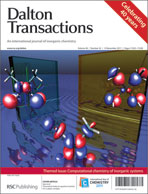The fate of actinyl species in the environment is closely linked to oxidation state, since the reduction of An(VI) to An(IV) greatly decreases their mobility due to the precipitation of the relatively insoluble An(IV) species. Here we study the mechanism of the reduction of [AnO2]2+ (An = U, Np, Pu) both in aqueous solution and by Fe(II) containing proteins and mineral surfaces, using density functional theory calculations. We find a disproportionation mechanism involving a An(V)–An(V) cation–cation complex, and we have investigated how these complexes are formed in the different environments. We find that the behaviour of U and Pu complexes are similar, but the reduction of Np(V) to Np(IV) would seems to be more difficult, in line with the experimental finding that Np(V) is generally more stable than U(V) or Pu(V). Although the models we have used are somewhat idealised, our calculations suggest that there are strong similarities between the biotic and abiotic reduction pathways.
You have access to this article
 Please wait while we load your content...
Something went wrong. Try again?
Please wait while we load your content...
Something went wrong. Try again?
![Graphical abstract: The mechanism of the reduction of [AnO2]2+ (An = U, Np, Pu) in aqueous solution, and by Fe(ii) containing proteins and mineral surfaces, probed by DFT calculations](/en/Image/Get?imageInfo.ImageType=GA&imageInfo.ImageIdentifier.ManuscriptID=C1DT10700C&imageInfo.ImageIdentifier.Year=2011)

 Please wait while we load your content...
Please wait while we load your content...